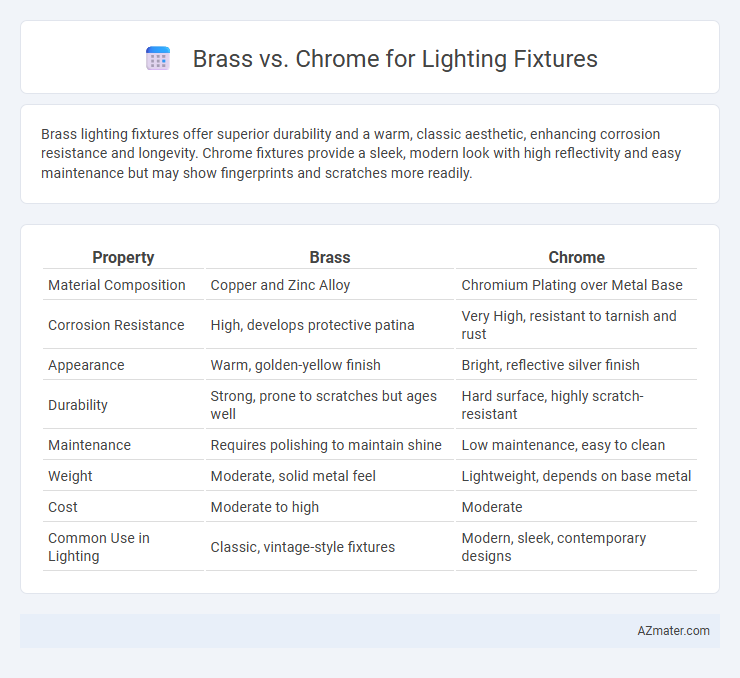Brass lighting fixtures offer superior durability and a warm, classic aesthetic, enhancing corrosion resistance and longevity. Chrome fixtures provide a sleek, modern look with high reflectivity and easy maintenance but may show fingerprints and scratches more readily.
Table of Comparison
| Property | Brass | Chrome |
|---|---|---|
| Material Composition | Copper and Zinc Alloy | Chromium Plating over Metal Base |
| Corrosion Resistance | High, develops protective patina | Very High, resistant to tarnish and rust |
| Appearance | Warm, golden-yellow finish | Bright, reflective silver finish |
| Durability | Strong, prone to scratches but ages well | Hard surface, highly scratch-resistant |
| Maintenance | Requires polishing to maintain shine | Low maintenance, easy to clean |
| Weight | Moderate, solid metal feel | Lightweight, depends on base metal |
| Cost | Moderate to high | Moderate |
| Common Use in Lighting | Classic, vintage-style fixtures | Modern, sleek, contemporary designs |
Introduction to Brass and Chrome Lighting Fixtures
Brass lighting fixtures offer a warm, timeless appeal with their natural golden tones and excellent corrosion resistance, making them ideal for both vintage and contemporary interiors. Chrome fixtures provide a sleek, reflective finish that enhances modern and minimalist designs through their high durability and resistance to tarnishing. Both materials serve as popular choices in lighting due to their combination of aesthetic appeal and long-lasting performance.
Material Composition: Brass vs Chrome
Brass lighting fixtures consist primarily of copper and zinc, providing natural antimicrobial properties and a warm, golden hue that enhances decor with durability and corrosion resistance. Chrome fixtures are made from steel or brass coated with a thin layer of chromium, offering a reflective, polished surface that is highly resistant to tarnish and easy to clean. The material composition impacts not only the fixture's aesthetic appeal but also its longevity and maintenance requirements in various environments.
Aesthetic Appeal: Visual Differences
Brass lighting fixtures offer a warm, golden hue with a classic, vintage charm that enhances traditional and rustic interior designs, while chrome fixtures provide a sleek, reflective silver finish ideal for modern, minimalist aesthetics. The patina that develops over time on brass adds character and depth, contrasting with the consistently shiny and polished surface of chrome, which maintains a contemporary, clean look. Choosing between brass and chrome influences the fixture's visual impact, affecting the room's overall ambiance and style coherence.
Durability and Longevity Comparison
Brass lighting fixtures offer exceptional durability due to their corrosion-resistant properties and strength, making them ideal for long-term use in various environments. Chrome fixtures provide a sleek, modern finish but may be more susceptible to scratching and tarnishing over time, especially in high-humidity areas. Brass's natural resistance to wear and its ability to develop a protective patina contribute to superior longevity compared to the more maintenance-intensive chrome surfaces.
Maintenance and Cleaning Requirements
Brass lighting fixtures develop a natural patina over time that requires gentle cleaning with a mixture of mild soap and water to maintain their warm appearance, avoiding abrasive materials that can damage the finish. Chrome fixtures demand regular wiping with a soft cloth and a non-abrasive cleaner to preserve their shiny, reflective surface and prevent water spots or fingerprints. Both materials benefit from routine dusting, but chrome tends to show smudges more easily, necessitating more frequent cleaning for a pristine look.
Cost Considerations of Brass and Chrome
Brass lighting fixtures typically come with a higher upfront cost due to the material's durability and luxurious appearance, making them a popular choice for premium designs. Chrome fixtures are generally more affordable, offering a sleek, modern look while being cost-effective for budget-conscious projects. Long-term maintenance costs for brass can be higher due to polishing needs, whereas chrome requires less upkeep but may show fingerprints and smudges more prominently.
Compatibility with Interior Design Styles
Brass lighting fixtures offer a warm, vintage appeal that complements traditional, industrial, and mid-century modern interiors, enhancing cozy and classic atmospheres. Chrome fixtures provide a sleek, reflective surface ideal for contemporary, minimalist, and modern design schemes, contributing to clean lines and a polished look. Combining these metals with corresponding design elements ensures harmonious integration and accentuates the overall aesthetic of the space.
Environmental Impact and Sustainability
Brass lighting fixtures offer superior sustainability due to their recyclability and durability, reducing waste and the need for frequent replacements. Chrome finishes often involve electroplating processes that can release harmful chemicals and heavy metals into the environment, raising concerns about pollution. Choosing brass with eco-friendly manufacturing practices supports a lower carbon footprint and promotes long-term environmental responsibility.
Popular Applications in Modern Lighting
Brass and chrome are popular finishes in modern lighting fixtures, each suited to specific design aesthetics and applications. Brass is favored in industrial and vintage-style lighting for its warm, rich tones that complement wood and leather accents in residential and hospitality settings. Chrome's sleek, reflective surface is ideal for contemporary and minimalist lighting designs, commonly used in kitchens, bathrooms, and office spaces for a clean, modern look.
Choosing the Right Finish for Your Space
Brass lighting fixtures offer a warm, vintage aesthetic that complements traditional and mid-century modern interiors, while chrome provides a sleek, reflective surface ideal for contemporary and industrial designs. Consider the overall color scheme and lighting ambiance; brass enhances cozy, inviting environments with its golden tones, whereas chrome brightens spaces with its clean, polished look. Durability and maintenance also influence choice--brass develops a natural patina over time, adding character, whereas chrome resists tarnishing and is easier to clean, maintaining its shiny appearance.

Infographic: Brass vs Chrome for Lighting Fixture
 azmater.com
azmater.com